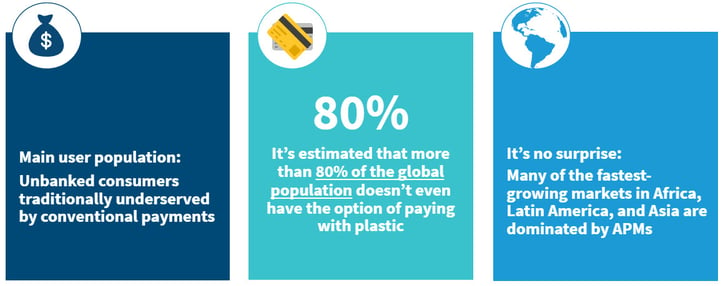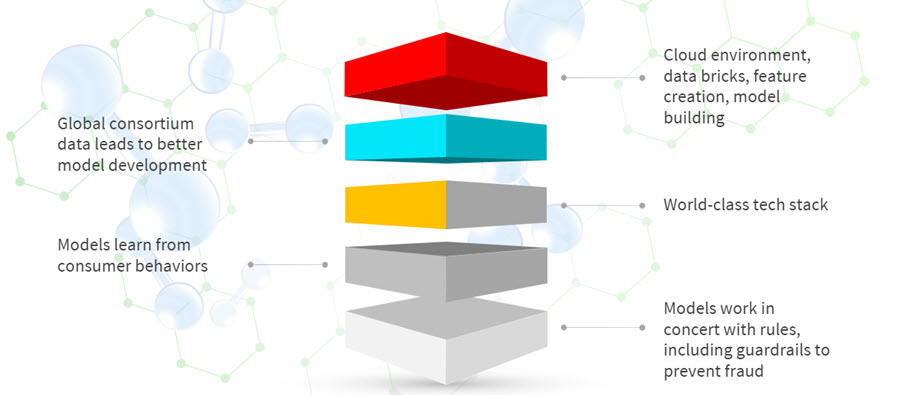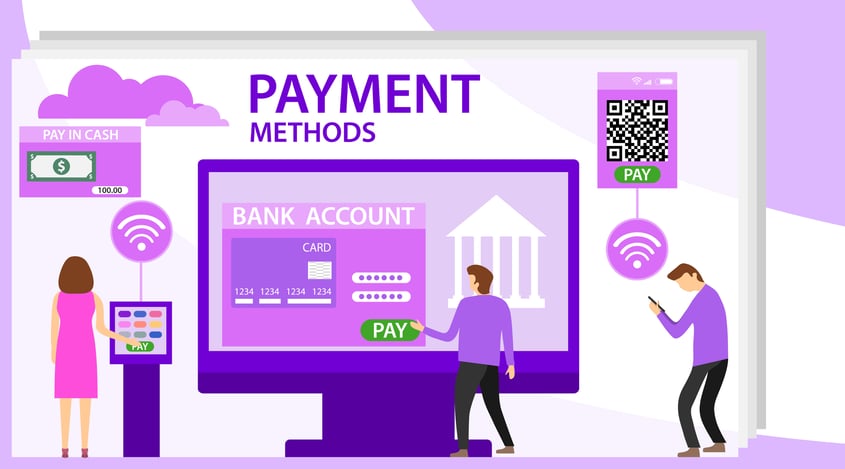Alternative payment methods (APMs) are growing across the globe with no slowdown in sight. But, what are alternative payment methods? How can eCommerce merchants capitalize on this trend while also mitigating payment fraud? Keep reading to learn all about APMs!
First things first: why should merchants care about APMs at all? Considering that APM payment volume reached $19T globally in 2022, the use of alternative payment methods are projected to grow about three times as fast as card payments from 2022 to 2027 according to a report by Boston Consulting Group..
Additionally, an ACI Worldwide study found that mobile wallet adoption is on the rise across all age groups with 25% of consumers saying they expect to use mobile wallets somewhat or much more frequently in the next year than they do now.
Based on these statistics and projections, an Ernst & Young study about alternative payment methods reports that "more than 85% of merchants are planning to accept new APMs in the next 1-3 years."

Who Uses Alternative Payment Methods?
The primary user population contains a segment of consumers classified as unbanked and underbanked based on the fact that these shoppers are just starting their credit journey and haven't yet built a credit profile. Especially in countries and areas with emerging markets, bank accounts and other banking tools can be difficult for these consumers to come by either because of the lack of a credit profile or because the generation relies more heavily on mobile technology than plastic credit cards.
If 80% of the global population doesn't even have the option of paying with plastic, eCommerce stores and marketplaces have an untapped sector of shoppers that needs some attention. Early adopters--merchants who work to facilitate APM acceptance--will realize the most potential from the APM population.
Why Are APMs Important for Merchants?
- More convenient, efficient and secure than cash
- Tailor APM options to the individual, allowing for a more customized experience
- Some support seamless cross-border payments, enabling merchants to compete globally
- APM platforms help merchants collect and analyze transactional data for growth opportunities
Challenges with APMs
- No standardized chargeback/dispute process around APMs
- Lack basic policies and regulations that define usage parameters
- May not offer same level of identity verification tools as traditional financial institutions
- Fraud detection for global transactions can be more difficult for merchants to manage
Fraud in Alternative Payment Methods
It might not come as a surprise to learn that APM fraud isn't all that different from payment fraud in general.
Be sure to check out our Payment Fraud 101 article to learn all about fraud types, fraud detection and prevention.
Much like other forms of payment fraud, the APM space is dealing with identity fraud, vishing/phishing, data breaches, account takeover, device theft and SIM cloning, and more! It's critical for merchants to safely adopt APM acceptance while also fortifying their fraud defense strategies. This really means that eCommerce and physical location merchants should be partnering with fraud prevention companies like Vesta to ensure that they find the right balance between providing an excellent customer experience and mitigating payment fraud.
Let's explore some of these fraud types in greater detail. Be sure to check out our blog post, Types of eCommerce Fraud and How to Protect Against Them.
Account Takeover: This type of fraud happens when an unauthorized user gains access to a customer account. While this could happen by sharing login credentials, fraudsters acquire customer login details most often through data breaches and illegal reselling. Bad actors use a cardholder's accounts to make as many purchases as possible before the victim realizes that account takeover has ever happened.
Triangulation Fraud: Triangulation fraud is when a legitimate customer makes a legitimate purchase from an illegitimate third-party fraudster. For example, if a cardholder completes a transaction on Amazon (a marketplace with thousands of sellers), but the seller has fraudulently purchased the product from another merchant, this is triangulation fraud.
SIM Cloning: This type of fraud happens when a legitimate SIM card is copied and used by the fraudster. The cloned SIM card is used in a device to intercept calls and messages as well as any digital wallet stored on the SIM card. This enables fraudsters to make purchases that will be charged to the original SIM card.
Payment Fraud Is Becoming More Sophisticated
As fraudsters and their methods become more and more sophisticated, shouldn't your fraud mitigation strategy outpace them? The answer is, "Yes!" Unfortunately, fraud patterns and methods seem to shift and pivot incredibly fast these days, and most eCommerce stores deploy a single fraud-fighting strategy that, frankly, just isn't good enough.
Traditional fraud prevention measures lack the necessary means to identify today's tech-savvy fraudsters. As Vesta's very own senior vice president of Decision Science and Analytics, Kevin Siegel, points out, "Fraudsters have access to robust information systems and use the same types of analytics techniques that we (fraud prevention companies) have. They're combining multiple sources of information together to form more complicated attacks."
In the traditional fraud prevention model, the techniques tend to operate in a silo, evaluating just one risk at a time. To optimize the way we fight back, fraud prevention companies moved to a more layered approach. To really provide a robust fraud-fighting toolset, companies need to be able to look at all of the data tied to a transaction. That means email addresses, phone numbers, physical addresses, card credentials, IP addresses and more.
Of course, it's virtually impossible for merchants, payment processors, and even some fraud prevention companies to analyze multiple data points in real time without negatively impacting the customer experience or without approving too many fraudulent transactions. This is precisely why companies should look beyond the data points to the connections that link them. When this happens, fraud prediction efforts improve significantly.

So, how can merchants improve their decisioning? That's where machine learning (ML) and artificial intelligence (AI) comes in, and they rely on graph databases to store the information and analyze the information. It sounds simple, right? Collect as much information as possible, analyze the data points and the connections between them, identify fraud rings, and approve legitimate transactions.
The biggest roadblock for this methodology, as far as merchants go, is finding the right partner. There are many fraud prevention vendors out there, but if they're not leveraging consortium data, they're not a top vendor.
For an in-depth exploration of how to use graph databases in payment fraud prevention, check out our comprehensive article.
Did You Know? Vesta is the leading fraud prevention platform based on machine learning models trained on over 27 years of transactional data. The truth is that nobody even comes close to our success in the fraud prevention space!
To explore comprehensive fraud solutions that incorporate AI and ML, explore the resources provided by Vesta. These state-of-the-art technologies are designed to help you detect fraudulent behavior with unmatched accuracy. We're so confident in our Payment Guarantee fraud solution that we'll cover the cost of fraud on any approved transaction that comes through our platform--guaranteed.
In a world where global transactions are the lifeblood of business success, safeguarding your customers' payments and money transfers is no longer a choice—it's a necessity. By integrating AI and ML into your fraud prevention arsenal, you can fortify your business against the ever-present threat of fraud. These technologies adapt and evolve alongside the dynamic landscape of cyber threats, providing your business with a robust defense against this persistent menace.
Contact us today to discover how AI and ML can be your partners in this ongoing battle against APM fraud, ensuring your business thrives in a rapidly changing world.
.png)
.png)
%20(1).png)




